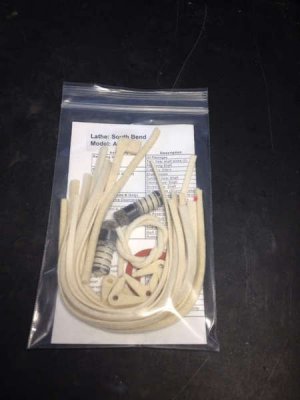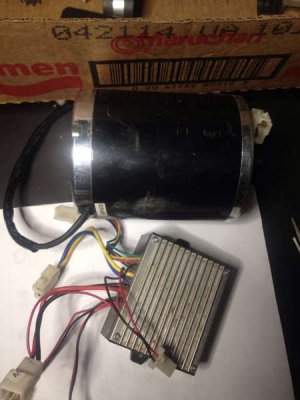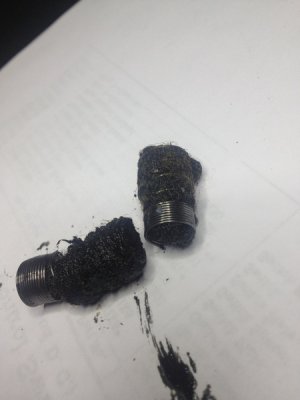1946 Southbend 9" Model A Restoration
Thanks! I think so too, but I imagine that the chemical gods have some oxidizing punishment in store for those who don't paint!
There was too much paint to do all in one step. 3 colors, starting with what looked like army green (we'll see who purchased it when I get my serial card). I started with a spray on chemical stripper. It's a thick powerful and fast formula so I don't have to worry about dripping onto surfaces I don't want to etch. Then scraped/brushed off what I could. Castings are hard to clean completely, especially in these complex shapes, so I used a combination of 3 different shapes of extra fine wire wheels on 1/4" arbor with my die grinder (also known as the big rotozip) at a low speed so as not to remove any metal. There's a 3" wheel, a 2" cone, and a densely packed 1" brass bulb shape I like. All castings apart from the bed took less than an hour to clean like that.
The last step hasn't been done on those parts yet. Paint doesn't stick too well to polished metal, and i hate doing things twice that should only be done once, so I'll etch it before painting.
I'll clean first with warm water and TSP. Then wipe down with alcohol. Then mix up a pint of 90/10, maybe 80/20, water/phosphoric acid, and mist it onto the surfaces to be painted. Usually about 15min or so is enough to give the paint something to grab onto.
!!!ACID SAFETY NOTE!!!!
REMEMBER YOUR 3 A'S WHEN MIXING ACID!! ALWAYS ADD ACID TO WATER! They have a synergistic effect when mixed and generate heat, that is to say, the mixture heats the water, and the ratio of acid to water dictates how much! If you poor water into acid it can boil the water and splatter you with hot acid! Not a good day in the shop! Also never poor live acids down the drain. You can use baking sodas to alter the PH, baking soda is probably safer, but amonia will work too. Add slowly and check with pool test strips to ensure its balanced before pooring.
I have mine back at the shop still, it's cut but I'll measure when I get back if nobody else has answered. I've read that correct belt length is important to these lathes running vibe free.
PS: I just accidentally figured out how the parser interprets a code comment LOL
Chad
Chad, those bare castings are really nice. Did you clean them up with a wire whee, or a buff? They look too good to cover them up with paint!
_____________
Thanks! I think so too, but I imagine that the chemical gods have some oxidizing punishment in store for those who don't paint!
There was too much paint to do all in one step. 3 colors, starting with what looked like army green (we'll see who purchased it when I get my serial card). I started with a spray on chemical stripper. It's a thick powerful and fast formula so I don't have to worry about dripping onto surfaces I don't want to etch. Then scraped/brushed off what I could. Castings are hard to clean completely, especially in these complex shapes, so I used a combination of 3 different shapes of extra fine wire wheels on 1/4" arbor with my die grinder (also known as the big rotozip) at a low speed so as not to remove any metal. There's a 3" wheel, a 2" cone, and a densely packed 1" brass bulb shape I like. All castings apart from the bed took less than an hour to clean like that.
The last step hasn't been done on those parts yet. Paint doesn't stick too well to polished metal, and i hate doing things twice that should only be done once, so I'll etch it before painting.
I'll clean first with warm water and TSP. Then wipe down with alcohol. Then mix up a pint of 90/10, maybe 80/20, water/phosphoric acid, and mist it onto the surfaces to be painted. Usually about 15min or so is enough to give the paint something to grab onto.
!!!ACID SAFETY NOTE!!!!
REMEMBER YOUR 3 A'S WHEN MIXING ACID!! ALWAYS ADD ACID TO WATER! They have a synergistic effect when mixed and generate heat, that is to say, the mixture heats the water, and the ratio of acid to water dictates how much! If you poor water into acid it can boil the water and splatter you with hot acid! Not a good day in the shop! Also never poor live acids down the drain. You can use baking sodas to alter the PH, baking soda is probably safer, but amonia will work too. Add slowly and check with pool test strips to ensure its balanced before pooring.
Does anybody know the correct V-Belt size to use from the countershaft to spindle on a horizontal drive bench model SB9".
_____________
I have mine back at the shop still, it's cut but I'll measure when I get back if nobody else has answered. I've read that correct belt length is important to these lathes running vibe free.
PS: I just accidentally figured out how the parser interprets a code comment LOL
Chad
Last edited:



